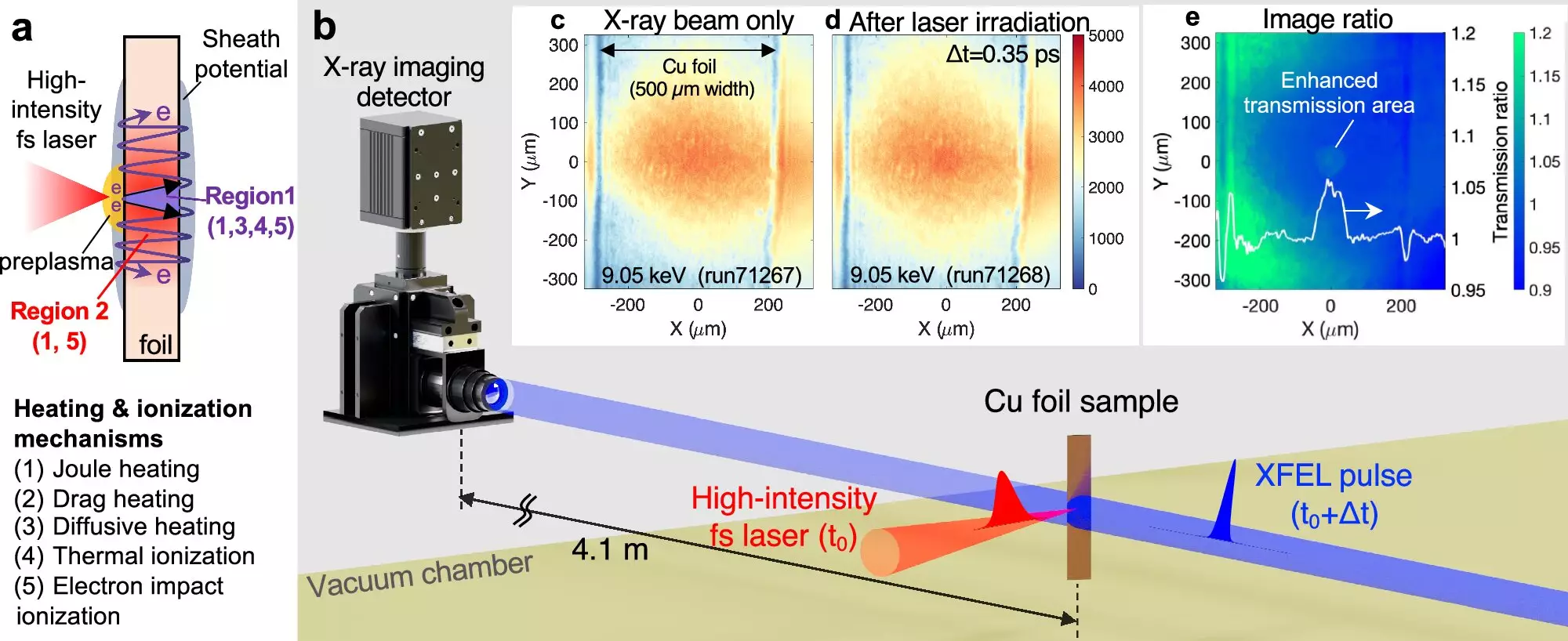The intriguing phenomenon of warm dense matter (WDM) represents a unique state of material that occurs under extreme conditions, particularly when metals like copper are subjected to high-powered laser pulses. This state, although described as “warm,” is characterized by staggering temperatures nearing 200,000 degrees Fahrenheit, creating a scenario where solid materials briefly transform into a dense plasma. The exploration of this transformation is critical not only in understanding the behavior of materials under intense conditions but also in expanding our knowledge of astrophysics and laser fusion energy.
Recent advancements in laser technology and experimental methodologies have paved the way for groundbreaking research in this field. A key study led by Hiroshi Sawada, an associate professor at the University of Nevada, Reno, alongside international collaborators, has offered new insights into how materials like copper heat and cool post-laser exposure. This study utilized advanced techniques involving ultrashort-duration X-ray pulses sourced from the X-ray Free Electron Laser (XFEL) facility in Japan to capture temporal changes in temperature and state, providing a clearer picture of plasma dynamics.
The employed pump-probe technique, where an intense laser pulse heats the material (the pump) followed by an X-ray pulse capturing the resulting state (the probe), allows researchers to observe phenomena that were previously elusive due to the incredibly rapid changes occurring within the material. This innovative approach represents a significant leap forward in the study of transient states of matter.
One of the notable challenges in this research domain is the sheer speed of the interactions; in a fraction of a trillionth of a second, significant changes can occur at an atomic scale. The researchers anticipated that the laser-induced transformation in copper would yield classical plasma; however, they were met with unexpected results, observing a warm dense matter state instead. These findings underline the necessity of developing more refined observation techniques for accurately diagnosing warm dense matter.
By repeatedly conducting experiments and altering the timing between the pump and probe lasers, the research team was able to meticulously track the heat dynamics within the copper. As they collected data from numerous shots—each effectively destroying the sample—they garnered the most precise insights into how heat transfers and the plasma state evolves on a micron scale.
The implications of these findings extend far beyond the immediate field of materials science; they touch on various fields including high-energy-density science, plasma physics, and astrophysics. The researchers’ work provides critical data that could inform theoretical models surrounding the formations of dense matter within giant planetary interiors and the behavior of materials in extreme environments, such as those found in stellar phenomena.
Moreover, the study highlights a crucial aspect of modern scientific research: the competitive nature of beam time on high-powered laser facilities like XFEL, which can take years to access. Consequently, the results generated from carefully planned experiments become even more valuable; they help form a framework for subsequent investigations.
As the field continues to evolve, the potential applications of this research are boundless. Future investigations may leverage next-generation facilities combining high-energy kilojoule lasers and advanced imaging techniques to further explore WDM states and the implications of heat transfer through various materials. Emerging platforms like the NSF OPAL laser at the University of Rochester and the upcoming MEC-U facility at SLAC are expected to enhance the understanding of how microscopic imperfections in materials can influence thermal dynamics.
In addition, as researchers integrate findings on different materials and energies, a broader spectrum of applications could emerge. From developing enhanced materials for nuclear fusion processes to practically applicable insights in chemical engineering, the trajectory of this research hints at forthcoming innovations that could reshape our understanding of material science and energy dynamics.
The research spearheaded by Sawada and his team represents a landmark achievement in the exploration of warm dense matter. The application of sophisticated laser technologies to unravel the complexities of thermal dynamics at the atomic level has opened doors to transformative discoveries. As researchers continue to probe the interactions between light and matter under extreme conditions, the outcomes will likely contribute to diverse fields, enriching our scientific landscape and driving future advancements in technology and energy sustainability.


Leave a Reply